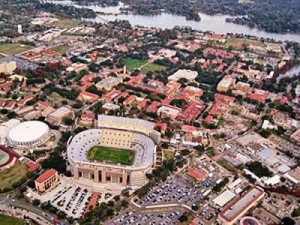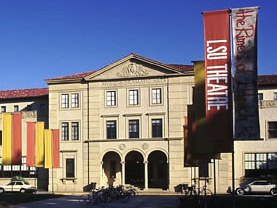» posted on Saturday, December 15th, 2012 by Linda Lou Burton
Geaux Tigers!
 Linda Burton posting from Baton Rouge, Louisiana – “I’m studying opera at LSU,” Dwayne told me, in basso tones. “I play piano too, and I used to direct our church choir,” said this Vicksburg, Mississippi native who has come south to school. Dwayne is the first person I talked to at my hotel in Baton Rouge, he has the front-desk afternoon-evening checkin job. I arrived early; it was an easy drive south from Jackson with no unusual change of landscape to report.
Linda Burton posting from Baton Rouge, Louisiana – “I’m studying opera at LSU,” Dwayne told me, in basso tones. “I play piano too, and I used to direct our church choir,” said this Vicksburg, Mississippi native who has come south to school. Dwayne is the first person I talked to at my hotel in Baton Rouge, he has the front-desk afternoon-evening checkin job. I arrived early; it was an easy drive south from Jackson with no unusual change of landscape to report.  I-55 south is heavy on piney woods and light on traffic; I think “pleasant” would be the word. Traffic expands to mad-hatter frenzy when you hit I-12 west; many tankers headed towards this town of oil refineries. What else will I find in Baton Rouge? I asked Dwayne for directions to the capitol and downtown; on the map he outlined a route that would lead me through the LSU campus. I know about LSU and football, having sons whose Saturdays have always been entwined with the goings-on of the SEC. But I don’t know LSU beyond that, so I did a little reading up when I got to my room. Geaux Tigers was the first thing I saw.
I-55 south is heavy on piney woods and light on traffic; I think “pleasant” would be the word. Traffic expands to mad-hatter frenzy when you hit I-12 west; many tankers headed towards this town of oil refineries. What else will I find in Baton Rouge? I asked Dwayne for directions to the capitol and downtown; on the map he outlined a route that would lead me through the LSU campus. I know about LSU and football, having sons whose Saturdays have always been entwined with the goings-on of the SEC. But I don’t know LSU beyond that, so I did a little reading up when I got to my room. Geaux Tigers was the first thing I saw.
 Louisiana State University and Agricultural and Mechanical College, shortened to Louisiana State University, shortened to LSU, (easier to manage in conversation!) has been around a while. It started out as Louisiana State Seminary of Learning & Military Academy in 1853 – an interesting combination of studies, to be sure. That was in Pineville; in 1926 the Baton Rouge campus was dedicated. Today you’ll find about 250 Italian Renaissance buildings spread on 650 acres along the banks of the Mississippi River. And, about 30,000 students in 14 schools and colleges. Research goes on here too; some 800 sponsored research projects funded by NIH, NEH, NASA, and more.
Louisiana State University and Agricultural and Mechanical College, shortened to Louisiana State University, shortened to LSU, (easier to manage in conversation!) has been around a while. It started out as Louisiana State Seminary of Learning & Military Academy in 1853 – an interesting combination of studies, to be sure. That was in Pineville; in 1926 the Baton Rouge campus was dedicated. Today you’ll find about 250 Italian Renaissance buildings spread on 650 acres along the banks of the Mississippi River. And, about 30,000 students in 14 schools and colleges. Research goes on here too; some 800 sponsored research projects funded by NIH, NEH, NASA, and more.
 Now, about that SEC football team. The Tigers started playing football in 1893; they took on the “Tigers” name from a Civil War military group; in 1935 they got the idea to purchase a real tiger for a mascot. Student donations led to the purchase of Mike the tiger; he lived for 20 years. Now they’re up to Mike VI, a Bengali-Syberian who weighs in at 500 pounds. Mike VI made his debut in Tiger Stadium October 6, 2007, during the Florida-LSU game. This sixth tiger mascot lives well; his 13,000 square-foot home has the natural look, including grass; but also elements of the school’s renaissance architecture. He eats about 25 pounds of food a day; it’s a formulated zoo-carnivore diet – hamburger meat fortified with B and E vitamins that keep his skin and hair in great condition. The average lifespan for a tiger in the wild is about 8-10 years; a tiger in captivity may live 20 years. Mike VI has his own web page; tune in to the live cam at http://www.mikethetiger.com/ .
Now, about that SEC football team. The Tigers started playing football in 1893; they took on the “Tigers” name from a Civil War military group; in 1935 they got the idea to purchase a real tiger for a mascot. Student donations led to the purchase of Mike the tiger; he lived for 20 years. Now they’re up to Mike VI, a Bengali-Syberian who weighs in at 500 pounds. Mike VI made his debut in Tiger Stadium October 6, 2007, during the Florida-LSU game. This sixth tiger mascot lives well; his 13,000 square-foot home has the natural look, including grass; but also elements of the school’s renaissance architecture. He eats about 25 pounds of food a day; it’s a formulated zoo-carnivore diet – hamburger meat fortified with B and E vitamins that keep his skin and hair in great condition. The average lifespan for a tiger in the wild is about 8-10 years; a tiger in captivity may live 20 years. Mike VI has his own web page; tune in to the live cam at http://www.mikethetiger.com/ .
As to Tiger Stadium, where those home football games are played; it is legendary for its crowd noise. It holds just about 92,542 noisy people; in the 1988 game against Auburn (when LSU won 7-6 in the last seconds of the game), the crowd’s roar registered 4.7 on a seismograph, shaking the ground in a small earthquake! It was originally nicknamed “Deaf Valley” because of the excruciating levels of sounds; but “Death Valley” is the name that caught on.
 But we started out talking about music, remember? LSU’s School of Music has been accredited since 1931; the program today includes 70 faculty and staff, and 450 students. It offers the choice of three undergraduate and three graduate degrees; divisions include academic studies, bands, ensembles and conducting, instrumental, keyboard, music education, and voice/opera.
But we started out talking about music, remember? LSU’s School of Music has been accredited since 1931; the program today includes 70 faculty and staff, and 450 students. It offers the choice of three undergraduate and three graduate degrees; divisions include academic studies, bands, ensembles and conducting, instrumental, keyboard, music education, and voice/opera.
I’ll be listening for Dwayne at the Met one day, belting it out like a true LSU tiger. But the sounds won’t be excruciating; instead they will be earth-shaking basso tones. Way to geaux!
About the LSU School of Music http://www.music.lsu.edu/prospective/index.html
